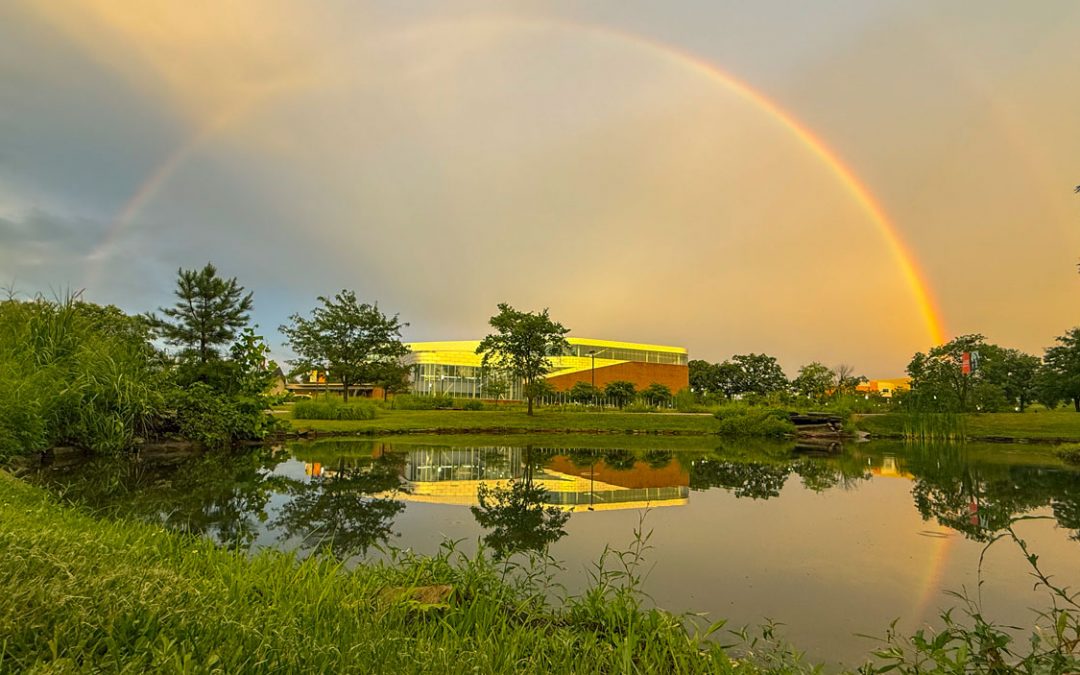
Lynn Staley, a teaching professor in the Department of English, saw the impact of Title IX in her own life as a women’s basketball player at Kalamazoo College in the early 1980s. She’s watched it continue to grow in the decades since as more and more women have benefited from opportunities to compete in sports. (Photo by August Jennewein)
Today marks the 50th anniversary of the day President Richard Nixon signed Title IX of the Education Amendments Act of 1972 into law.
Title IX declared that “No person in the United States shall, based on sex, be excluded from participation in, be denied the benefits of, or be subjected to discrimination under any education program or activity receiving Federal financial assistance.”
That groundbreaking piece of legislation is credited with dramatically increasing the number of women and girls competing in sports throughout the country by ensuring that schools and universities provide equal opportunities as given to their male counterparts. While there remains room for improvement – female athletes and their athletic programs still operate with lower budgets and with fewer teams and scholarships than male programs – female sports participation has grown by 1,057% at the high school level and 614% at the college level since Title IX’s passage.
“Title IX has changed the lives of generations of women since it was first enacted in 1972,” said Lynn Staley, a teaching professor in the Department of English and an affiliate faculty member in the Gender Studies Program at the University of Missouri–St. Louis. “I was a real beneficiary of that.”
Staley felt the impact of Title IX as a young woman playing NCAA Division III women’s basketball at Kalamazoo College in the early 1980s. She remains an avid fan and observer of women’s sports, serving as the faculty athletics representative for UMSL’s Department of Athletics the past two years. In the latest installment of its Ask an Expert series, UMSL Daily spoke to Staley about Title IX’s legacy over the past 50 years.
As an athlete, what was your own experience like following the passage of Title IX?
I was hugely aware of it as a high school athlete. When I was in high school in the late ’70s, early ’80s, Title IX had only been in place for about a decade, and we were seeing more and more teams develop. We did not have a high school track team for girls when I was in school, but we started one my junior year, and I joined that team and I became a distance runner, primarily to stay in shape for basketball season. I was able to letter in three sports in high school and then went on to play college basketball. Those kinds of opportunities did not happen for women before 1972, and since then, over the course of the decades, we have seen women advance to where schools have an excellent balance of athletic opportunities for women and men. Men’s teams are supportive of women’s teams, and women are getting more and more attention and there’s more focus. Most importantly, female athletes have been able to move into professions related to athletics that would have been very much closed off to them before Title IX was instituted. That’s not to say we don’t need to see way more women as athletic directors and head coaches and assistant coaches and trainers. We need to see even more of them at the professional level. But I think we are making more and more inroads because more and more women are going into athletics and see the value of it in their lives.
The legislation obviously is broader than athletics. Why is it so tied in the public mind to sports and was that the intent when the legislation was created?
It covers everything related to equal opportunity in education. For example, if you pay attention to Ruth Bader Ginsburg’s life story and you hear about how she was treated in law school, she was one of very few women admitted to law school at the time and was definitely not treated equally. Just like many people in minoritized communities now, you have to work twice as hard to get half as far, right? We know this about the way our country works. For women, that had gone on for a very long time, and Title IX really was designed to at least address that in educational settings.
The sports part of it feels more high profile maybe because it seems more glamorous to talk about shooting hoops than it is to talk about getting admitted to a business program. But if you think about, for example, some industries tend to be very male-dominated. Look at IT and computer science, where it’s been difficult for women to make inroads and where often they have not had access to boardrooms and to corporate leadership programs and things like that. Title IX has not solved all of those problems, but it has at least given women the opportunity to pursue all of the same interests that men have been able to pursue.
We need the media, we need the business world, we need all kinds of organizations to acknowledge that no matter what gender you are, no matter where you are on the gender spectrum, that you have a brain and you know how to use it and you are capable of doing a good job. I think that athletics has sort of become a symbol for that, but the larger message of Title IX is that women, like everyone, are capable in every field, and that they should not be kept back or held down because of misperceptions about gender differences.
What was it like as a woman or girl involved in athletics in the ’70s?
I think at the time it could be a struggle to learn how to do things because there weren’t a lot of clubs sports back in the ’70s for girls. I didn’t learn how to play basketball until I got to high school. My dad taught me a lot. My dad taught me how to how to throw a football at a very early age, how to throw a baseball, how to catch. But I didn’t get a chance to be on a team until the late ’70s, and that was when there was more and more of a push to add more women’s sports after Title IX was enacted. But then you had to find coaches. You had to find time to do that. There needed to be additional budgets for uniforms. We always got hand-me-down uniforms. Our uniforms were always old. The boys teams might get new uniforms every year. We would get the varsity uniforms handed down to JV. Nothing ever fit quite right. They were always kind of awful.
I was talking to Katie Vaughn, our women’s basketball coach, about this, and she comes from Iowa. Iowa was one of the last states where in basketball girls were allowed to play by the boys’ rules. It took them a long time. They were still playing in zones through the ’80s.
I don’t think I started to see women having a huge influence in sports until I got to the college level. We had a woman athletic director. My coach was a woman and an amazing player and coach. I saw lots of women in leadership positions at that collegiate level, and that taught me that those doors were opening. Within 20 years of that legislation, we were seeing more and more women in sport. I think it’s slowed down. I don’t think we’ve seen enough women moving into professional sports.
What was Division III college basketball like at Kalamazoo College in the early 1980s?
It was a lot like UMSL. It was a small school. It was a small liberal arts college with very intense academics. Division III gets the smallest portion of the NCAA budget. Division III athletes don’t receive scholarships for athletics. But my team was very skilled. I worked with a lot of really great athletes. We did not win a ton of games when I was there, but we had some really amazing experiences. The Virginia Slims women’s tennis circuit came to campus. Kalamazoo is a big tennis town, and they always host the junior nationals there, and they brought in Virginia Slims, and stars like Billie Jean King, Chris Evert, Rosie Casals came to campus. It was while basketball was in season, so the women’s basketball team was asked to sort of be their assistants. They took over our locker room, and we were there to give them everything they needed and follow them around. So I got to kind of trail after Billie Jean King, who was just my idol. She was not terribly friendly. It was funny. She knew perfectly well that we all absolutely worshipped her, but she was all business and very professional but not super fan-friendly. So we learned: Don’t act like a geeky fan person. Instead, do your job. Be professional.
At the college level was when I really started to see women as role models. Throughout high school, I mostly had male coaches. That was the atmosphere. I think at the college level, I saw more and more women getting involved, and I think that women added a different dimension to coaching. I hope that all of the attention that’s gone to mental health issues for athletes – which have been brought out by both male and female athletes and trans athletes – I think, all of the talk about how we need to be better about taking care of each other’s mental health applies.
As somebody who has continued to follow sports since you played, how much appreciation do you have for the success of Title IX over the past 50 years in terms of participation now compared to then?
I love to see families come out and support all of their kids playing sports. There’ll be families where all of the children are involved. Everybody’s playing. It’s not just a dad throwing a baseball to his son. It’s everybody in the family participating. Like I said before, I think sports is in the realm of where we are most egalitarian, where we are most likely to treat each other the way that human beings should treat each other. You challenge each other, and then you shake hands at the end of it. I think sportspersonship is something that everyone can benefit from as a life lesson. The fact that Title IX has made it possible for women to have access to opportunities where they learn about those important aspects of sport – not just the athleticism itself – but how it is to be fair and to treat your opponents with respect, that’s really important.
Title IX, though, has also very importantly protected women’s rights in other areas. The sexual harassment components of Title IX, the reporting aspects so that people can come to an institution and say, ‘I am not being treated fairly’ or ‘My colleagues are not being treated fairly.’ Title IX has opened the door for discussions across the educational world about equality. It has not solved all of those problems, clearly. I don’t want to be naive about that. But I think it has certainly moved many things in the right direction, and I think it’s been a huge factor. I’m a feminist. To me, Title IX has had a huge impact on how women see themselves in American culture.














